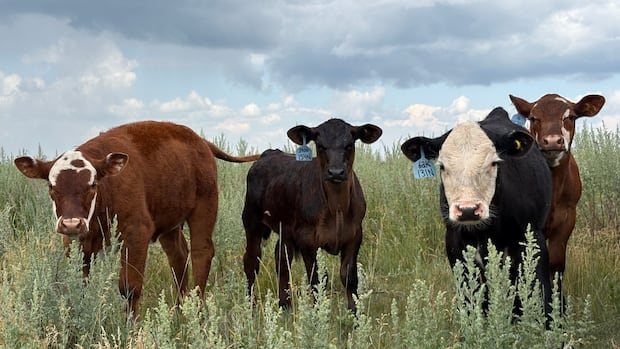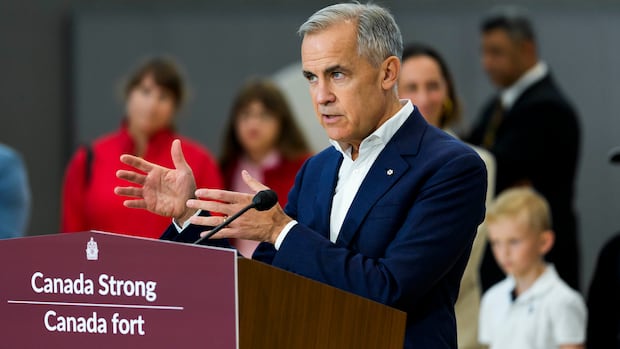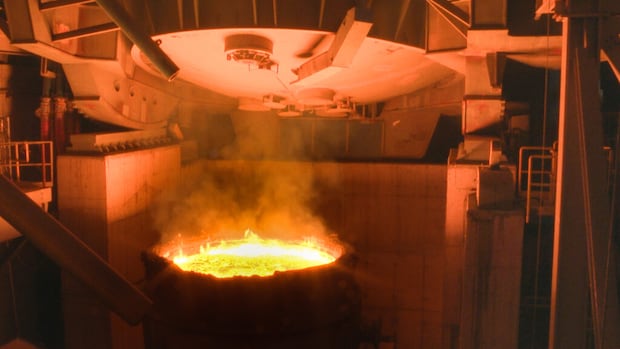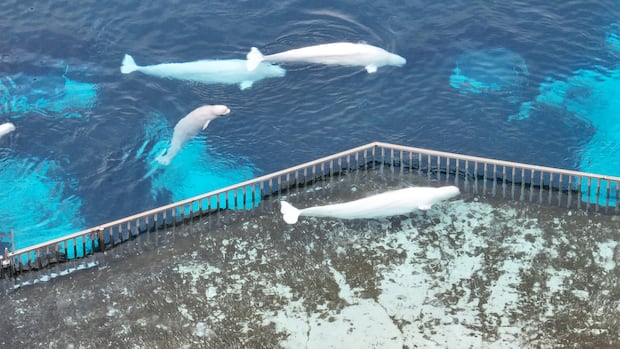When calving season rolls around, cattle rancher Karyn Neilson doubles as a masseuse.
She gives every other newborn calf on her central Alberta farm a one-minute, head-to-hoof massage — hoping it’ll be the start of a healthier and more profitable herd.
“We do that to imitate what its mother will do and create a positive bond with the animal,” said Neilson, co-owner of Neilson Beef in Stettler, Alta.
“In future interactions we have with it, it won’t be viewing us as a predator. It has a positive interaction with us and then it’s just easier to handle and such in the future.”
Using gentle but firm pressure, she starts the spa treatment at the top of the calf’s head before moving down their backs and legs, while keeping an eye on their tail.
“When you can hit a spot where their tails wag, you can tell you’re making them extra happy.”
Neilson has done this to hundreds of newborn calves in the last five years, as part of a research study with Olds College.
They’re looking to see if using this technique in the first week of life — a critical period of brain development — can reduce the calves’ stress, make them healthier and heavier, and ultimately help beef producers make more money.
47-pound weight gain
Lead researcher Désirée Gellatly compares the technique, known more formally as tactile stimulation, to skin-to-skin contact with newborn human babies.
“The first time [producers] interact with the beef calf is normally averse — it’s to do ear tagging, it’s to do shots, it’s to do castration. We are trying to see if with one minute of gentle touch at the time of processing the calf, we can switch how the calf perceives us,” said Gellatly, research scientist for Olds College’s Technology Access Centre for Livestock Production.
Inspired by a similar study she worked on with dairy calves in Brazil, she’s also hoping to improve calves’ health.
Between Neilson Beef and another cattle ranch in southern Alberta, Gellatly is set to analyze data from roughly 900 animals next month.
She said the initial pilot study, conducted over two years starting in 2020, showed some positive signs.
“We found in the first year that animals that received the massage were 47 pounds heavier than animals that did not receive the massage,” she said.
“In the second year, we found they were about 20 pounds heavier than animals that did not receive the massage.”
This year, the researchers and producers are conducting DNA testing to rule out whether the sire’s genetics are contributing to the weight differences. Gellatly and her research team plan to submit their scientific paper in the next couple of months.
“The goal is that producers start doing this not only because it can improve the profitability, but because it’s the right thing to do, right? We are taking care of these animals. We are using these animals. So I think it’s fair with them that we treat them right.”
$150 a minute
With nearly 15,000 followers on TikTok, sharing this novel approach has been met with some skepticism by other producers.
But for Lance Neilson, Karyn’s husband, the extra time spent is worth it.

“Right now, a calf is worth, say, about $5 a pound when you wean them from their mother. So if you’re getting an extra 30 lbs., we’re talking $150 for a minute of work,” he said.
“$150 a minute — that’s a pretty good payday for you.”
He said massages alone aren’t magic, but the bond formed sets the stage to layer on other low-stress handling techniques throughout the cows’ lives.
The Neilsons say it has also reduced their stress.
“We are calmer. The cows are calmer…. We don’t groan if we have to go to do cows like maybe we did five or six years ago,” said Karyn.
Low-stress handling
Near Nanton, Alta., John Smith and Laura Laing of Platteau Cattle Co. — winners of this year’s environmental stewardship award from Alberta Beef Producers — also joined the study two years ago, in a relentless pursuit of improving their cattle’s welfare.
They said they receive similar pushback, but also a lot of comments from curious folks. They say the credibility is ultimately in the research.
“There’s a lot of factors and some of those things are really hard to account for. But I know from boots on the ground, what we see is … something good happens when you do it. And I think any producer, if they took the time, the 60 seconds, they would feel the same thing that we feel,” said Smith.
Laing said the biggest challenge they face is not massaging all of the cows because they’re still in the study and need a control group.
That’s going to change once the data collection stage is over.
“We’re just going to massage every calf,” said Smith.
They say they’re hopeful it will help through the generations, so that those retained into their breeding program are safer to handle.







